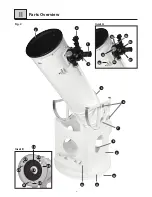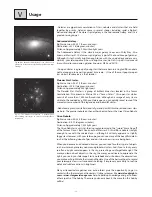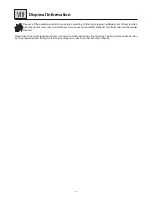
- 10 -
V
Using a Dobsonian Telescope
• Never lubricate the Teflon pads on the ground plate. Your Dobsonian has been designed
with some inherent friction. You want the telescope to move easily when you position it, but
you also want it to stay in the position you place it. Using any kind of oil, silicone spray, wax,
or grease will ruin the performance by causing the telescope to move too easily. Just keep
these bearing surfaces clean.
• The altitude bearing surfaces (Fig. 1, 7) of the telescope are lightly lubricated at the factory
for optimum performance. Over a period of time, these surfaces may become dry or dirty.
Simply clean off the bearing surfaces with a dry cloth or paper towel. Do not use solvents or
alcohol-based cleaning solutions as this may damage the bearings or the painted surfaces
of the telescope.
• You will notice that your telescope will move in altitude by raising and lowering the tube,
and in azimuth by rotating the base. As you observe objects in the night sky they will appear
to drift out of the field of view due to the Earth’s rotation. To keep an object centered in the
field of view, just lightly nudge the telescope in the proper direction. This may take a little
practice at first, but you’ll soon get the hang of it.
• Be sure the mount is placed on a relatively level surface to allow proper operation. Each of
the three feet should be in firm contact with the surface and not wobble. If you are in an
area with particularly rough or soft ground, it may be helpful to place the mount on a thick
piece of plywood.
• Part of the fun of using a Dobsonian type of telescope is the challenge of hunting for objects
in the night sky. Invest in some simple star charts and books that tell you how to locate
objects using a technique called “star hopping.” Once you begin learning the star patterns
and constellations, you’re well on your way to finding many amazing sights.
Calculating the Magnification
The magnification of a telescope is determined by two factors — the focal length of the
eyepiece and the focal length of the telescope.
To calculate the magnification of a given eyepiece use this formula:
Telescope focal length
Magnification = ----------------------------------
Eyepiece focal ength
For example, the included 25mm eyepiece will have a magnification of approximately 49x
when used with the 8” Dobsonian, which has a focal length of 1218mm.
1218
mm
Magnification = --------------- = 49x (approx. value)
25 mm
TIP: When beginning observations of an object, always start with your lowest power eyepiece.
Keep in mind that a bright, clearly resolved image will show far more detail than a poorly resolved
larger image.
Usage
Summary of Contents for Explore FirstLight 10" f/5 Dobsonian
Page 19: ...19...




















